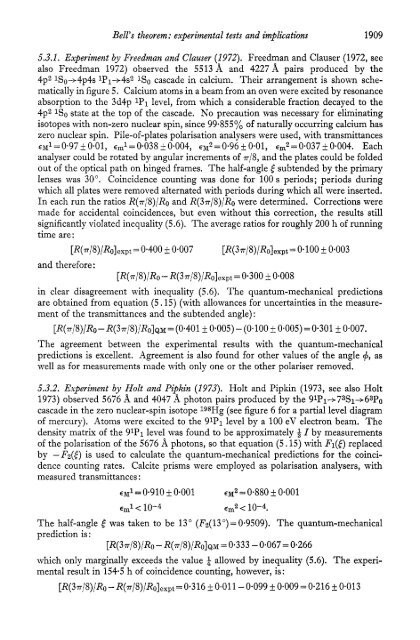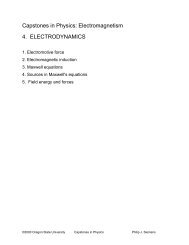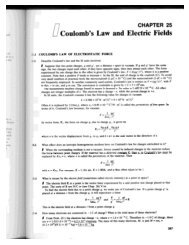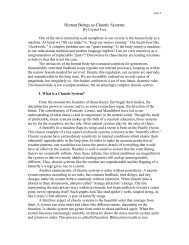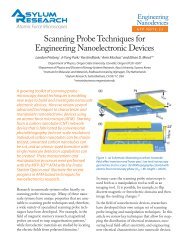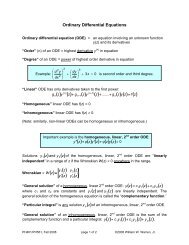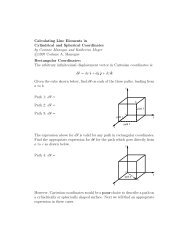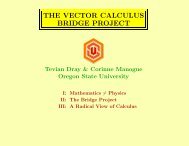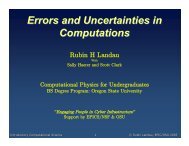Bell's theorem : experimental tests and implications - Physics at ...
Bell's theorem : experimental tests and implications - Physics at ...
Bell's theorem : experimental tests and implications - Physics at ...
You also want an ePaper? Increase the reach of your titles
YUMPU automatically turns print PDFs into web optimized ePapers that Google loves.
<strong>Bell's</strong> <strong>theorem</strong>: <strong>experimental</strong> <strong>tests</strong> <strong>and</strong> <strong>implic<strong>at</strong>ions</strong> 19095.3.1. Experiment by Freedman <strong>and</strong> Clauser (1972). Freedman <strong>and</strong> Clauser (1972, seealso Freedman 1972) observed the 5513 a <strong>and</strong> 4227 A pairs produced by the4p2 1So+4p4s 1P1+4sz IS0 cascade in calcium. Their arrangement is shown schem<strong>at</strong>icallyin figure 5. Calcium <strong>at</strong>oms in a beam from an oven were excited by resonanceabsorption to the 3d4p 1P1 level, from which a considerable fraction decayed to the4p2 WO st<strong>at</strong>e <strong>at</strong> the top of the cascade. No precaution was necessary for elimin<strong>at</strong>ingisotopes with non-zero nuclear spin, since 99.855% of n<strong>at</strong>urally occurring calcium haszero nuclear spin. Pile-of-pl<strong>at</strong>es polaris<strong>at</strong>ion analysers were used, with transmittances~~1=0.97 k 0.01, ~~1=0*038 & 0.004, €$=Om96 k 0.01, ~,2=0*037 f 0.004. Eachanalyser could be rot<strong>at</strong>ed by angular increments of n/8, <strong>and</strong> the pl<strong>at</strong>es could be foldedout of the optical p<strong>at</strong>h on hinged frames. The half-angle 6 subtended by the primarylenses was 30". Coincidence counting was done for 100 s periods; periods duringwhich all pl<strong>at</strong>es were removed altern<strong>at</strong>ed with periods during which all were inserted.In each run the r<strong>at</strong>ios R(n/S)/Ro <strong>and</strong> R(3n/8)/& were determined. Corrections weremade for accidental coincidences, but even without this correction, the results stillsignificantly viol<strong>at</strong>ed inequality (5.6). The average r<strong>at</strong>ios for roughly 200 h of runningtime are:[R(n/S)/Ro]expt= 0.400 & 0.007[R(3~/8)/Ro]expt= 0.100 f 0.003<strong>and</strong> therefore:[R(n/8)/Ro - R(3~/8)/Ro]expt= 0.300 f 0.008in clear disagreement with inequality (5.6). The quantum-mechanical predictionsare obtained from equ<strong>at</strong>ion (5.15) (with allowances for uncertainties in the measurementof the transmittances <strong>and</strong> the subtended angle) :[R(n/8)/Ro-R(3n/8)/Ro]QM=(0'401 & 0*005)- (0.100 & 0*005)=0*301 f 0,007.The agreement between the <strong>experimental</strong> results with the quantum-mechanicalpredictions is excellent. Agreement is also found for other values of the angle $, aswell as for measurements made with only one or the other polariser removed.5.3.2. Experiment by Holt <strong>and</strong> Pipkin (1973). Holt <strong>and</strong> Pipkin (1973, see also Holt1973) observed 5676 A <strong>and</strong> 4047 A photon pairs produced by the 91P1-+73S1+63Pocascade in the zero nuclear-spin isotope 198Hg (see figure 6 for a partial level diagramof mercury). Atoms were excited to the glP1 level by a 100 eV electron beam. Thedensity m<strong>at</strong>rix of the glP1 level was found to be approxim<strong>at</strong>ely Q I by measurementsof the polaris<strong>at</strong>ion of the 5676 A photons, so th<strong>at</strong> equ<strong>at</strong>ion (5.15) with Fl(6) replacedby - F2(f) is used to calcul<strong>at</strong>e the quantum-mechanical predictions for the coincidencecounting r<strong>at</strong>es. Calcite prisms were employed as polaris<strong>at</strong>ion analysers, withmeasured transmittances :~~1=0*910 2 0.001 €M2=0*880 & 0.001< 10-4 10-4.The half-angle f was taken to be 13 O (F413") = 0.9509). The quantum-mechanicalprediction is :[R(3n/8)/RO- R(n/8)/Ro]QM=0*333 - 0*067= 0.266which only marginally exceeds the value & allowed by inequality (5.6). The <strong>experimental</strong>result in 154.5 h of coincidence counting, however, is:[R(3n/8)/Ro-R(.rr/8)/Ro],xpt=0.316 5 0.011 -0.099 & 0*009=0.216+ 0.013


